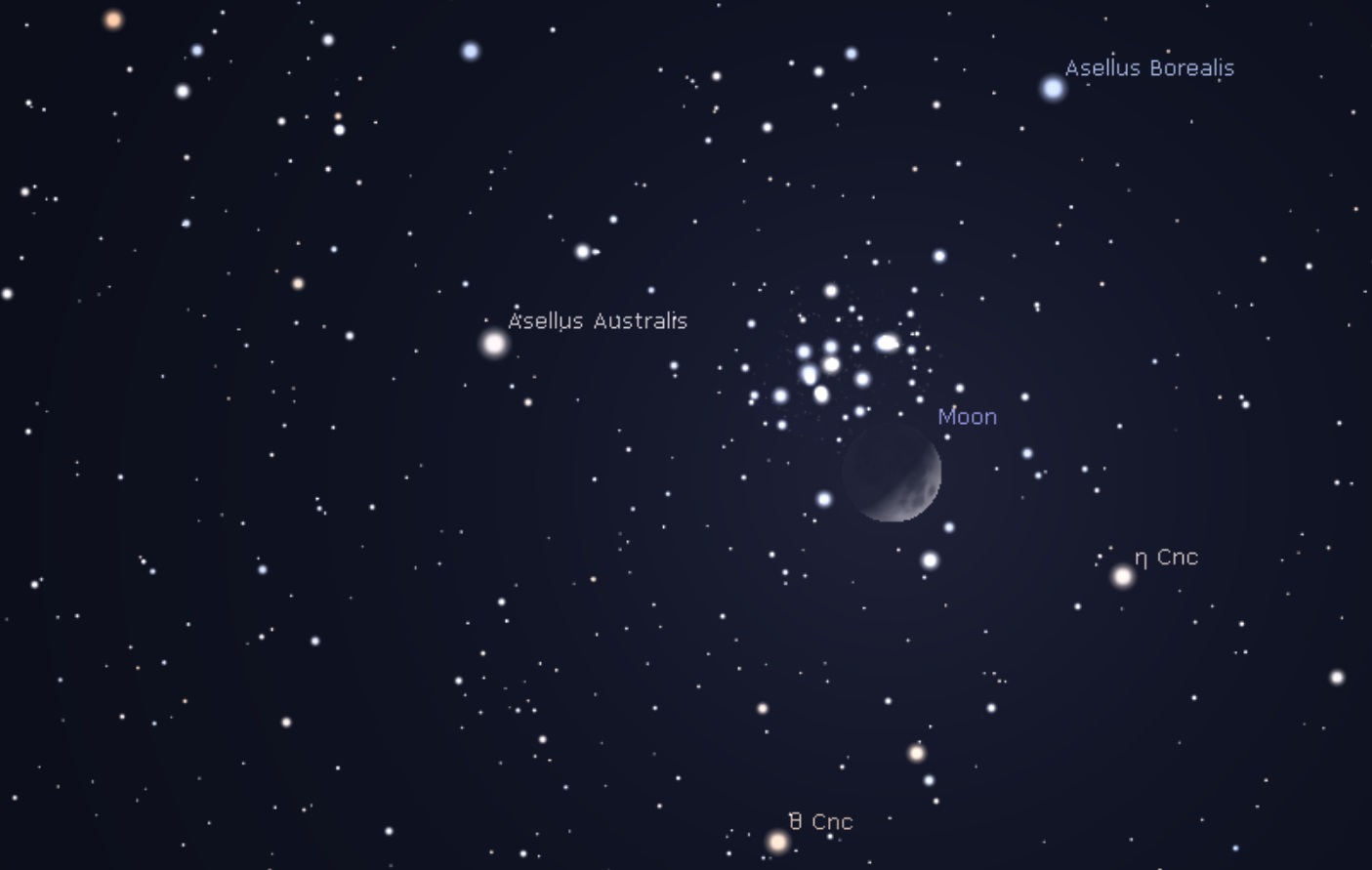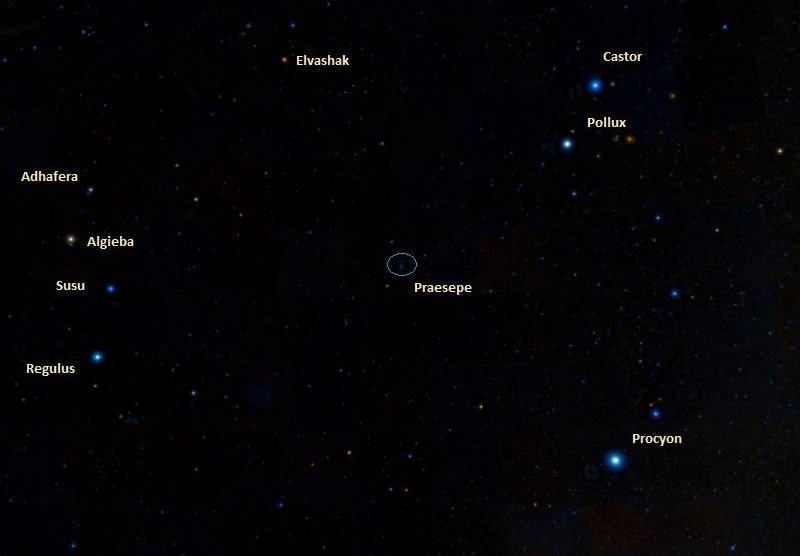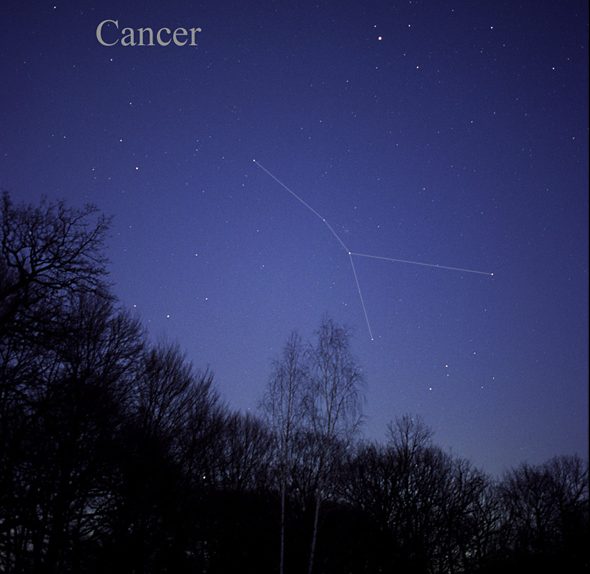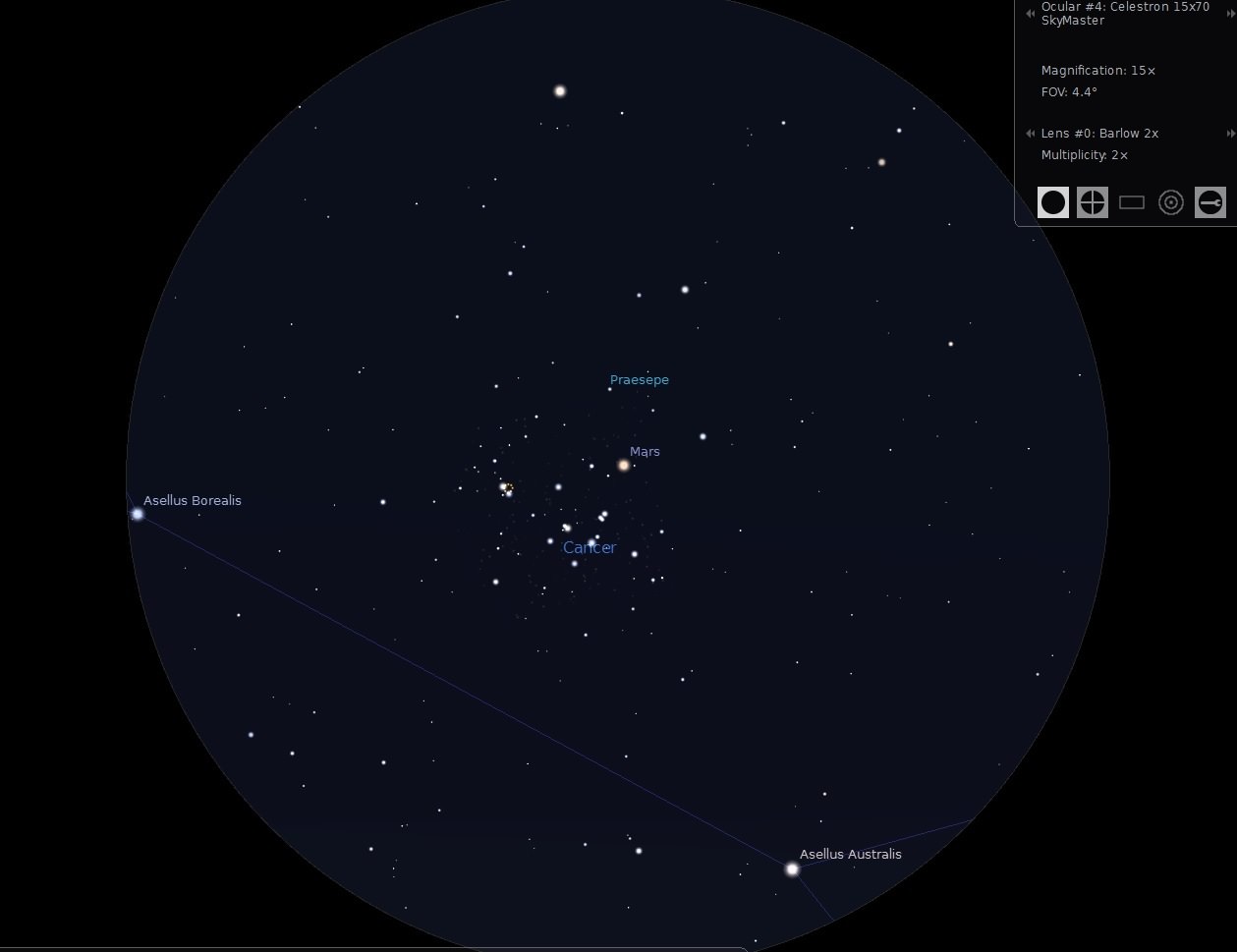Been following the Moon this week? The first sighting of the waxing crescent Moon this past weekend not only marked the start of the Muslim month of Ramadan worldwide, but also sets us up for an interesting Friday night encounter, as the waxing crescent Moon crosses the Beehive Cluster.
Continue reading “Watch the Moon Buzz the Beehive”Messier 44 – The Beehive Cluster (Praesepe)
During the 18th century, famed French astronomer Charles Messier noted the presence of several “nebulous objects” in the night sky. Having originally mistaken them for comets, he began compiling a list of them so that others would not make the same mistake he did. In time, this list (known as the Messier Catalog) would come to include 100 of the most fabulous objects in the night sky.
One of these is the Beehive Cluster (aka. Messier 44, or Praesepe), an open star cluster located in the the Cancer constellation. In addition to containing a larger population of stars than most clusters in its vicinity, it is also one of the nearest open clusters to the Solar System – at a distance of 577 light years (177 parsecs). As such, astronomers have been aware of it since Classical Antiquity.
Description:
According to ancient lore, this group of stars (often called the Praesepe) foretold a coming storm if it was not visible in otherwise clear skies. Of course, this came from a time when combating light pollution meant asking your neighbors to dim their candles. But, once you learn where it’s at, it can be spotted unaided even from suburban settings. Hipparchus called it the “Little Cloud,” but not until the early 1600s was its stellar nature revealed.
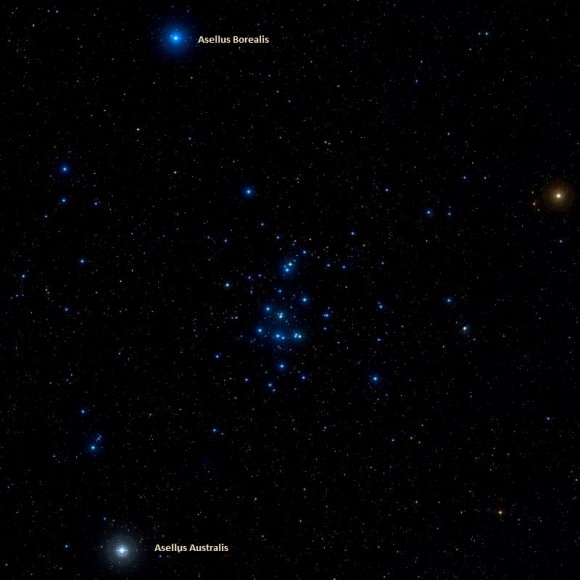
Believed to be about 550 light-years away, this awesome cluster consists of hundreds of members – with at least four orange giants and five white dwarfs. M44’s age is similar to that of the Pleiades, and it is believed that both clusters have a common origin. Although you won’t see any nebulosity in the Beehive, even the very smallest of binoculars will reveal a swarm of bright stars and large telescopes can resolve down to 350 faint stars.
Messier 44 is the nearest open cluster of its type to our Solar System, and it contains a larger star population than most other nearby clusters. Under dark skies the Beehive Cluster looks like a nebulous object to the unaided eye; thus it has been known since ancient times. The classical astronomer Ptolemy called it “the nebulous mass in the heart of Cancer,” and it was among the first objects that Galileo studied with his telescope.
The cluster’s age and proper motion coincide with those of the Hyades stellar association, suggesting that both share a similar origin. Both clusters also contain red giants and white dwarfs, which represent later stages of stellar evolution, along with main sequence stars of spectral classes A, F, G, K, and M. So far, eleven white dwarfs have been identified, representing the final evolutionary phase of the cluster’s most massive stars, which originally belonged to spectral type B. Brown dwarfs, however, are extremely rare in this cluster, probably because they have been lost by tidal stripping from the halo.
Messier 44 is home to 5 red giant stars and a handful of white dwarf stars. But, M44 also contains one peculiar blue star. Among its members, there is the eclipsing binary TX Cancri, the metal line star Epsilon Cancri, and several Delta Scuti variables of magnitudes 7-8, in an early post-main-sequence state. And in all those stars, there’s a lot of other peculiarities to be found!
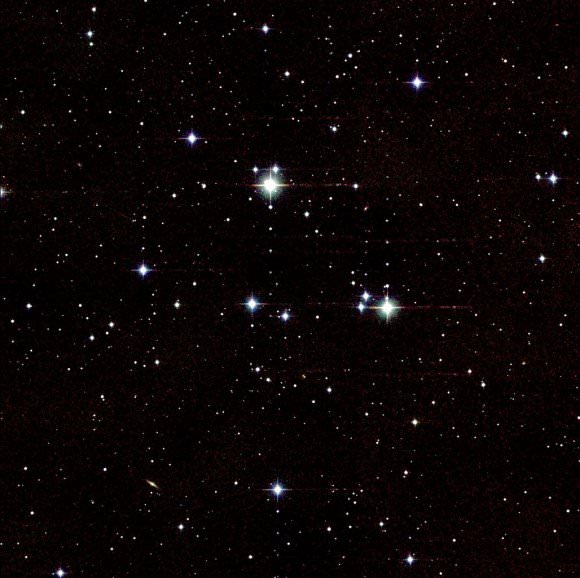
As Sergei M. Andrievsky indicated in a 1998 study:
“We present the results of a spectroscopic study of four blue stragglers from old galactic open cluster NGC 2632 (Praesepe). The LTE analysis based on Kurucz’s atmosphere models and synthetic spectra technique has shown that three stars, including the hottest star of the cluster HD73666, possess an uniform chemical composition: they show a solar-like abundance (or slight overabundance) of iron and an apparent deficiency of oxygen and silicon. Two stars exhibit a remarkable barium overabundance. The chemical composition of their atmospheres is typical for Am stars. One star of our sample does not share such uniform elemental distribution, being generally deficient in metals.”
But is there more hiding in there? Perhaps the kind of stuff that could eventually make planets? According to a 2009 study done by A. Gaspar (et al), this was certainly thought to the be the case:
“Mid-IR excesses indicating debris disks are found for one early-type and for three solar-type stars. The incidence of excesses is in agreement with the decay trend of debris disks as a function of age observed for other cluster and field stars. We show that solar-type stars lose their debris disk 24 um excesses on a shorter timescale than early-type stars. Simplistic Monte Carlo models suggest that, during the first Gyr of their evolution, up to 15%-30% of solar-type stars might undergo an orbital realignment of giant planets such as the one thought to have led to the Late Heavy Bombardment, if the length of the bombardment episode is similar to the one thought to have happened in our solar system.”
In September of 2012, two planets were confirmed to be orbiting around two separate stars in the Beehive Cluster. The finding was significant since the stars were similar to Earth’s Sun, and this was the first instance where exoplanets were found orbiting a Sun-like star within a stellar cluster. These planets were designated as Pr0201b and Pr0211b, both of which are “Hot Jupiters” (i.e. gas giants that orbit close to their stars). In 2016, additional observations showed that the Pr0211 system actually has two planets, the second one being Pr0211-c.
History of Observation:
This beautiful, nearby star cluster has been known since ancient times and played wonderful roles in mythology. Aratos mentioned this object as “Little Mist” as far back as 260 BC, and Hipparchus included this object in his star catalog and called it “Little Cloud” or “Cloudy Star” in 130 BC. Ptolemy mentions it as one of seven “nebulae” he noted in his Almagest, and describes it as “The Nebulous Mass in the Breast (of Cancer)”.
According to Burnham, it appeared on Johann Bayer’s chart (about 1600 AD) as “Nubilum” (“Cloudy” Object). It was even resolved by Galileo in 1609 who said: “The nebula called Praesepe contains not one star only but a mass of more than 40 small stars. We have noted 36 besides the Aselli (Gamma and Delta Cancri).”
Messier 44 was partly resolved by Orion nebula’s discoverer, Peiresc, in 1611, who said, “Nebula was seen in the vicinity of Jupiter to the east. in which more than 15 stars have been counted.” and added to Hevelius’ catalog as number 291. De Cheseaux charted it as his number 11 and Bode as his number 20. Small wonder Messier felt the need to add his own numbers to it as well when he recorded:
“At simple view [with the naked eye], one sees in Cancer a considerable nebulosity: this is nothing but a cluster of many stars which one distinguishes very well with the help of telescopes, and these stars are mixed up at simple view [to the unaided eye] because of their great proximity. The position in right ascension of one of the stars, which Flamsteed has designated with the letter c, reduced to March 4, 1769, should be 126d 50′ 30″, for its right ascension, and 20d 31′ 38″ for its northern declination. This position is deduced from that which Flamsteed has given in his catalog.”
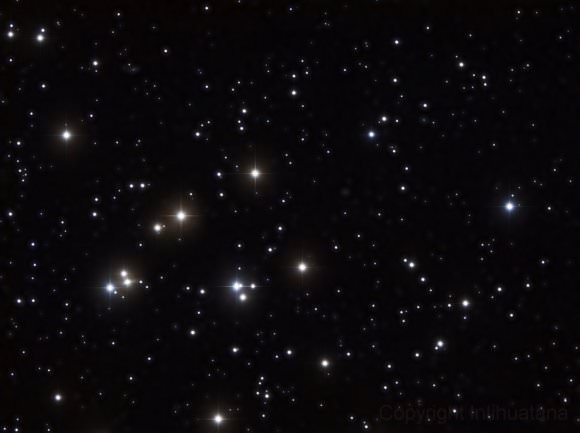
While Sir William Herschel would ignore it and Caroline Herschel would only write that she “observed it”, John Herschel would go on to give it an NGC designation and Admiral Smyth would sing its poetic praises. Is it possible that watching this star cluster could help fortell the weather? If you believe the words of Aratos, it just might.
“Watch, too, the Manger. Like a faint mist in the North it plays the guide beneath Cancer. Around it are borne two faintly gleaming stars, not far apart nor very near but distant to the view a cubit.s length, one on the North, while the other looks towards the South. They are called the Asses [in the constellation Cancer], and between them is the Manger. On a sudden, when all the sky is clear, the Manger wholly disappears, while the stars that go on either side seem nearer drawn to one another: not slight then is the storm with which the fields are deluged. If the Manger darken and both stars remain unaltered, they herald rain. But if the Ass to the North of the Manger shine feebly through a faint mist, while the Southern Ass is gleaming bright, expect wind from the South: but if in turn the Southern Ass is cloudy and the Northern bright, watch for the North wind.”
And watch for a swarm of incredible starlight!
Locating Messier 44:
Messier 44 is so bright that it easily shows to the unaided eye as a nebulous patch just above the conjunction of the faint, upside down “Y” asterism of the Cancer constellation. However, not everyone lives where dark skies are a rule – so try using both Pollux and Procyon to form the base of an imaginary triangle. Now aim your binoculars or finderscope near the point of the apex to discover M44 – the Beehive.
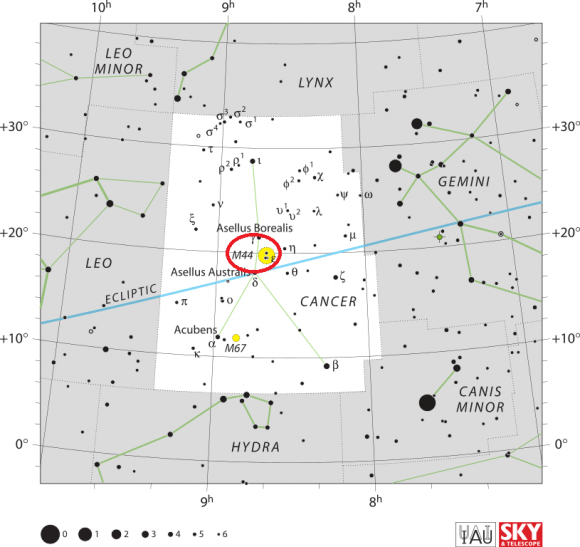
Since Messier 44 is about a degree and a half in diameter, it will require that you use your lowest magnification eyepiece in a telescope, and it is very well suited to binoculars of all sizes. Because its major stars are also quite bright, it stands up to urban sky and moonlight conditions, but many more stars are revealed with higher magnification and darker skies. Because M44 is very near the ecliptic plane, you’ll often find a planet or the Moon mixing it up with the stars!
Object Name: Messier 44
Alternative Designations: M44, NGC 2632, Beehive Cluster, The Praesepe, The Manger
Object Type: Open Galactic Star Cluster
Constellation: Cancer
Right Ascension: 08 : 40.1 (h:m)
Declination: +19 : 59 (deg:m)
Distance: .577 (kly)
Visual Brightness: 3.7 (mag)
Apparent Dimension: 95.0 (arc min)
We have written many interesting articles about Messier Objects here at Universe Today. Here’s Tammy Plotner’s Introduction to the Messier Objects, , M1 – The Crab Nebula, M8 – The Lagoon Nebula, and David Dickison’s articles on the 2013 and 2014 Messier Marathons.
Be to sure to check out our complete Messier Catalog. And for more information, check out the SEDS Messier Database.
Sources:
The Cancer Constellation
Welcome back to Constellation Friday! Today, we will be dealing with one of the best-known constellations, that crabby asterism known as “Cancer”!
In the 2nd century CE, Greek-Egyptian astronomer Claudius Ptolemaeus (aka. Ptolemy) compiled a list of the then-known 48 constellations. His treatise, known as the Almagest, would be used by medieval European and Islamic scholars for over a thousand years to come. One of these constellations is Cancer, which is represented by “the Crab”.
As one of the twelve constellations of the zodiac, this medium-sized constellation is located on the ecliptic plane, where it is bordered by Gemini to the west, Lynx to the north, Leo Minor to the northeast, Leo to the east, Hydra to the south, and Canis Minor to the southwest. Today, it is one of the 88 constellation that are recognized by the International Astronomical Union (IAU) today.
Name and Meaning:
In mythology, Cancer was part of the Twelve Labors of Hercules. While Hercules was busy fighting the multi-headed monster (Hydra), the goddess Hera – who did not like Hercules – sent the Crab to distract him. Cancer grabbed onto the hero’s toe with its claws, but was crushed by Hercule’s mighty foot. Hera, grateful for the little crustacean’s heroic sacrifice, gave it a place in the sky. Given that the crab did not win, the gods didn’t give it any bright stars.
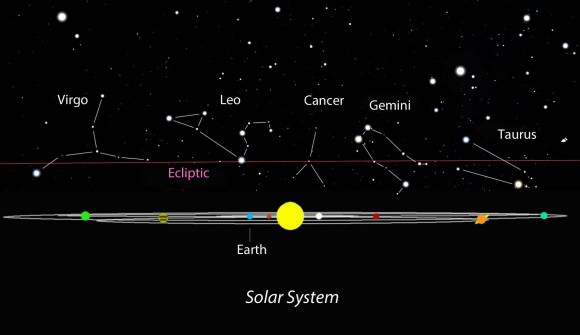
History of Observation:
The first recorded examples of the Cancer constellation come from the 2nd millennium BCE, where it was known to Akkadian astronomers as the “Sun of the South”. This was most likely due to its position at the summer solstice during ancient antiquity. By classical antiquity, Cancer came to be called the “Gate of Men”, based on the beleif that it was the portal through which souls came and went from the heavens.
Given its relative faintness in the night sky, Cancer was often described as the “Dark Sign” throughout history. For instance, the medieval Italian poet Dante alluded to its faintness and position of Cancer in heavens as follows (in the Paradiso section of The Divine Comedy):
“Then a light among them brightened,
So that, if Cancer one such crystal had,
Winter would have a month of one sole day.”
Cancer’s stature as a constellation of the Zodiac has remained steadfast over the millennia, thought its position has changed. Over two thousand years ago, the sun shone in front of the constellation during the Northern Hemisphere’s summer solstice. Today, the Sun resides in front of the constellation Taurus when the summer solstice sun reaches its northernmost point.
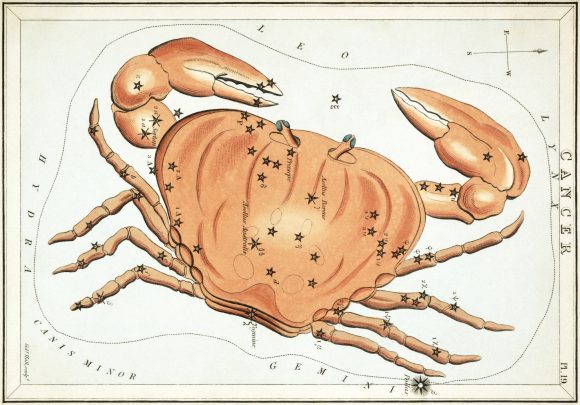
Notable Features:
Though comparatively faint, the Cancer constellation contains several notable stars. For starters, there is Beta Cancri, which is also known by the Arabic name of Al Tarf (“the eye” or “the glance”). Beta Cancri is the brightest star in Cancer and is about 660 times brighter than our Sun.
This K-class orange giant star is about 290 light years away from Earth, and is part of a binary system that includes a 14th magnitude star. This second star is so far away – about 65 times the distance of Pluto from the Sun – that their orbital period is at least 76,000 years!
Then there is Delta Cancri – an orange giant star approximately 180 light-years away. This is the second-brightest star in the Cancer constellation, and also where the famous Beehive Cluster (Messier 44) can be found (see below). It is also known by its Latin name of Asellus Australis, which means “southern donkey colt” (or “southern ass” if you’re feeling comedic!).
A bit further north is Gamma Cancri, an A-type white subgiant located 158 light years from Earth. Its Latin name is Asellus Borealis, which means (you guessed it!) “northern ass”. Both this star and Delta Cancri are significant because of their mythological connection and proximity to Messier 44.
Next up is Alpha Cancri, the fourth brightest star in the constellation, which is also known as Acubens. The star also goes by the names of Al Zubanah or Sertans, which are derived from the Arabic az-zub?nah (which means “claws”), while Sertan is derived from sara??n, which means “the crab.” Located approximately 174 light years from Earth, Alpha Cancris is actually a multiple star system – Alpha Cancri A and B (a white A-type dwarf and an 11th magnitude star, respectively.
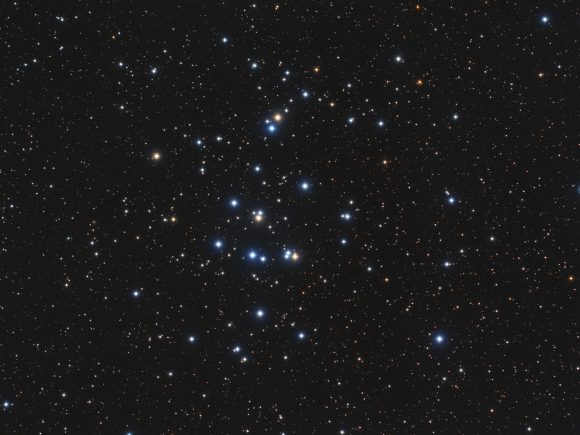
Cancer is also home to many Deep Sky Objects. For instance, there is the aforementioned Beehive Cluster (Messier 44). This open cluster is the nearest of its type relative to our Solar System, and contains a larger star population than most other nearby clusters. Under dark skies the Beehive Cluster looks like a nebulous object to the unaided eye; thus it has been known since ancient times.
The classical astronomer Ptolemy called it “the nebulous mass in the heart of Cancer,” and it was among the first objects that Galileo studied with his telescope. The cluster’s age and proper motion coincide with those of the Hyades stellar association, suggesting that both share a similar origin. Both clusters also contain red giants and white dwarfs, which represent later stages of stellar evolution, along with main sequence stars of spectral classes A, F, G, K, and M.
So far, eleven white dwarfs have been identified, representing the final evolutionary phase of the cluster’s most massive stars, which originally belonged to spectral type B. Brown dwarfs, however, are extremely rare in this cluster, probably because they have been lost by tidal stripping from the halo.
Then there’s M67, which can be viewed due west of Alpha Cancri. M67 is not the oldest known galactic cluster, but there are very few in the Milky Way known to be older. M67 is an important laboratory for studying stellar evolution, since all its stars are at the same distance and age, except for approximately 30 anomalous blue stragglers, whose origins are not fully understood.
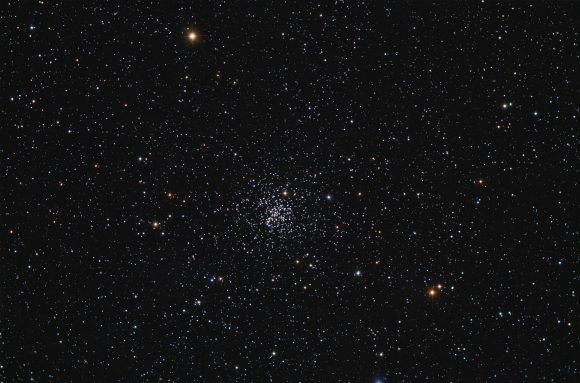
M67 has more than 100 stars similar to the Sun and many red giants, though the total star count has been estimated at over 500. The cluster contains no main sequence stars bluer than spectral type F, since the brighter stars of that age have already left the main sequence. In fact, when the stars of the cluster are plotted on the Hertzsprung-Russell diagram, there is a distinct “turn-off” representing the stars which are just about to leave the main sequence and become red giants.
It appears that M67 does not contain an unbiased sample of stars. One cause of this is mass segregation, the process by which lighter stars (actually, systems) gain speed at the expense of more massive stars during close encounters, which causes the lighter stars to be at a greater average distance from the center of the cluster or to escape altogether.
Then there’s NGC 2775, which is positioned some 60 million light years away. NGC 2775 is a peculiar blend of spiral galaxy with a smooth bulge in the center. The star formation is confined to this ring of tightly wound arms, and the galaxy has been the location of 5 supernovae explosions in the past 30 years!
Next up is DX Cancri, a faint, magnitude 14, cool red dwarf star that has less than 9% the mass of our Sun. It is a flare star that has intermittent changes in brightness by up to a five-fold increase. This star is far too faint to be seen with the naked eye, even though it is the 18th closest star system to the Sun at a distance of 11.82 light years, and is the closest star in the constellation Cancer.
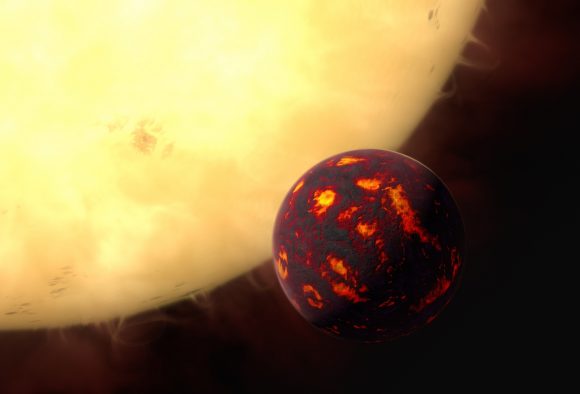
Now set your mark on 55 Cancri (located at RA 8 52 35 Dec +28 19 59). Also known as Rho1 Cancri, this binary star system is located approximately 41 light-years away from Earth and has a whole solar system of its own! The system consists of a yellow dwarf star and a smaller red dwarf star, separated by over 1,000 times the distance from the Earth to the Sun.
As of 2007, five extrasolar planets have been confirmed to be orbiting the primary – 55 Cancri A (the yellow dwarf). The innermost planet is thought to be a terrestrial “super-Earth” planet, with a mass similar to Neptune, while the outermost planets are thought to be Jovian planets with masses similar to Jupiter.
Finding Cancer:
As one of the 12 constellations along the ecliptic, Cancer is relatively easy to find with small telescopes and even binoculars. It lies in the second quadrant of the northern hemisphere (NQ2) and can be seen at latitudes between +90° and -60°. It occupies an area of 506 square degrees, making it the 31st largest constellation in the night sky.
There is only one meteor shower associated with the constellation of Cancer. The peak date for the Delta Cancrids is on or about January 16th. The radiant, or point of origin is just west of Beehive. It is a minor shower and the fall rate averages only about 4 per hour and the meteors are very swift.
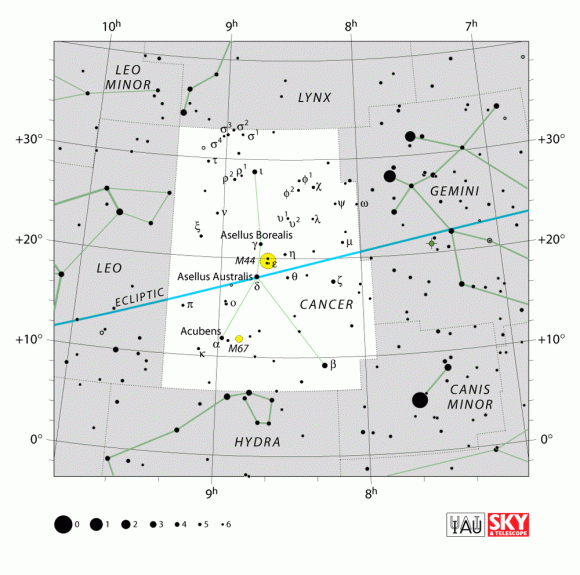
Like all of the traditional constellations that belong to the Zodiac family, the significance of Cancer has not waned, despite the passage of several thousand years. Best of luck finding it, though you won’t need much!
We have written many interesting articles about the constellation here at Universe Today. Here is What Are The Constellations?, What Is The Zodiac?, and Zodiac Signs And Their Dates.
Be sure to check out The Messier Catalog while you’re at it!
For more information, check out the IAUs list of Constellations, and the Students for the Exploration and Development of Space page on Cancer and Constellation Families.
Sources:
How to See Mars in September 2013: The Red Planet Pierces the Beehive & More
Launch season for Mars missions is almost upon us once again.
This is a time when spacecraft can achieve an optimal trajectory to reach the Red Planet, expending a minimal amount of fuel and taking the shortest period of time. This window of opportunity, which opens once every two years, always opens up about six months prior to Martian opposition.
For you stargazers, this is also the best time to observe the Red Planet as it makes its closest approach to Earth. And no, it won’t appear as large as a Full Moon, but it will make for a fine telescopic target.
During the last launch window in 2011-12, Mars Curiosity made the journey, and Russia’s Phobos-Grunt tried. Hey, it’s a tough business, this spaceflight thing. This time around, The Indian Space Research Organization (ISRO) hopes to launch its first ever interplanetary spacecraft, with its Mars Orbiter Mission departing on October 18th. NASA is also sending its Mars Atmosphere Volatile EvolutioN mission known as MAVEN to study the atmosphere of the Red Planet.
Opposition next occurs on April 8th, 2014, but the start of launch season always finds Mars emerging high to the east at dawn. Starting next week, Mars has some interesting encounters that are worth checking out as a prelude to the upcoming opposition season.
The planet Mars shines at +1.6 magnitude and is about 4” in size in September. This is a far cry from its maximum size of 15.1” that it will achieve next spring, and its grandest maximum size of 25.1” that it reached in 2003. All oppositions of Mars are not created equal, because of the planet’s 9.3% eccentric orbit.
But the good news is, we’re trending towards a better series of oppositions, which follow a roughly 15 year cycle. In 2018, we’ll see an opposition nearly as good as the 2003 one, with Mars appearing 24.1” in size. This is also the time frame that Dennis Tito wants to launch his crewed Mars 2018 flyby.
But back to the present. The action starts on September 2nd when the waning crescent Moon passes 6.1 degrees SSW of Mars.
Mars is currently in the constellation Cancer, and will actually transit (pass in front of) the open star cluster known as the Beehive or Messier 44, standing only 0.23 degrees from its center on September 8th. M44 is 1.5 degrees in size, and this presents an outstanding photo-op.
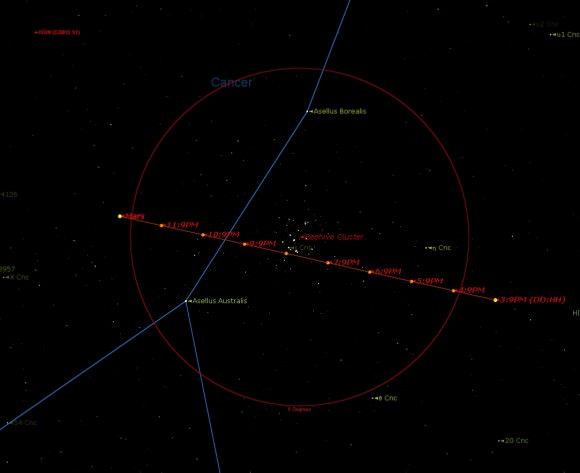
At high power, you might just be able to catch the real time motion of Mars against the background stars of M44. Mars currently rises three hours before the Sun, giving you a slim window to accomplish this feat.
Mars is also in the midst of a series of transits of the Beehive Cluster, with one occurring every other year. Mars last crossed M44 on October 1st, 2011. The next time you’ll be able to spy this same alignment won’t be until August 20th, 2015.
But another cosmic interloper may photo-bomb Mars in September.
We’re talking about none other than Comet C/2012 S1 ISON, the big wildcard event of the season. Comet ISON is just peeking out from behind the Sun now, and dedicated amateurs have already managed to recover it. “IF” it follows projected light curve predictions, ISON may reach binocular visibility of greater than +10th magnitude by October 1st and may breech naked eye visibility by early November.
ISON approaches within two degrees of Mars on September 27th. Its closest apparent approach is will be on Oct 18th at a minimum separation of 0.89 degrees, just over the size of a Full Moon. How bright ISON will actually be at that point is the question of the season. To quote veteran comet hunter David Levy, “Comets are like cats. They have tails, and they do whatever they want.” The closest physical approach of Mars and Comet ISON is on October 1st at 0.07 astronomical units, or 10.4 million kilometres apart. Both will be crossing over from the astronomical constellations of Cancer into Leo in late September.
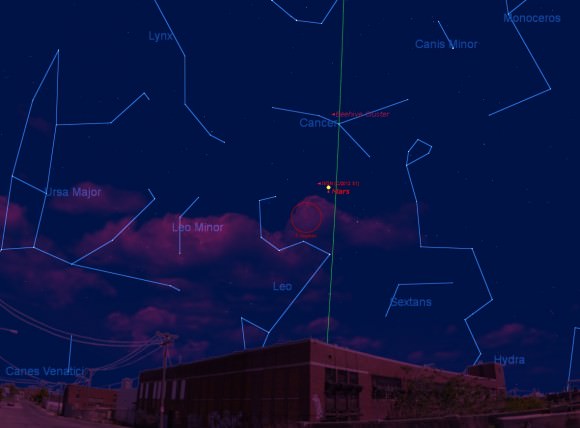
Mars gets another close shave from a comet next year, when Comet C/2013 A1 Siding Spring passes 123,000 kilometres from Mars on October 19th, 2014. Interestingly, MAVEN will be arriving just a month prior to this if it departs Earth at the start of its 21 day window. Engineers have noted that an increase in cometary dust may be a concern for the newly arrived spacecraft during insertion into Martian orbit.
MAVEN Principal Investigator Bruce Jakosky notes that the first concern is the safety of the spacecraft, the second is studies of Mars, and the third is, just perhaps, to carry out observations of the comet.
Look for more information on Universe Today about the Martian cometary flybys as each event gets closer.
September is a great time to begin observations of the Red Planet. Usually, 8” seconds in diameter is the threshold that is frequently quoted for the first surface features (usually to polar ice caps) to become apparent, but we’re already seeing astro-imagers getting detailed images of Mars, right now.
Be sure to follow Mars on its trek across the September dawn skies as robotic explorers prepare to embark on their epic journeys!

